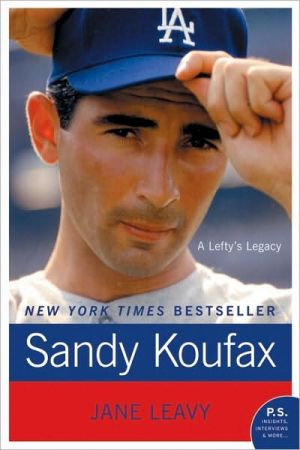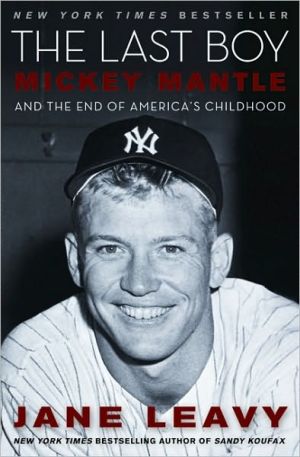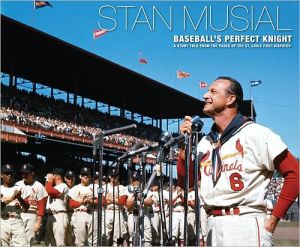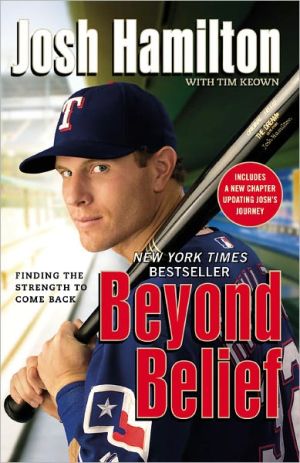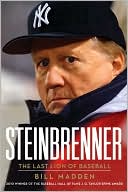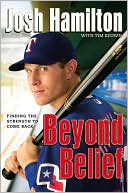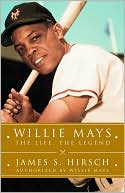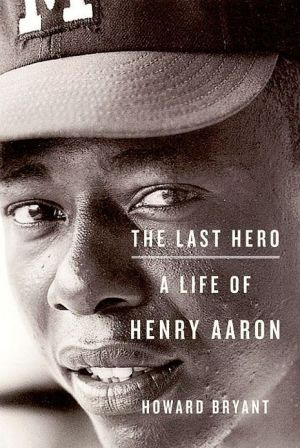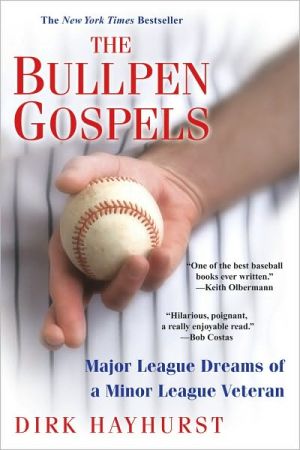Sandy Koufax: A Lefty's Legacy
No immortal in the history of baseball retired so young, so well, or so completely as Sandy Koufax. After compiling a remarkable record from 1962 to 1966 that saw him lead the National League in ERA all five years, win three Cy Young awards, and pitch four no-hitters including a perfect game, Koufax essentially disappeared. Save for his induction into the Hall of Fame and occasional appearances at the Dodgers training camp, Koufax has remained unavailable, unassailable, and unsullied, in the...
Search in google:
No immortal in the history of baseball retired so young, so well, or so completely as Sandy Koufax. After compiling a remarkable record from 1962 to 1966 that saw him lead the National League in ERA all five years, win three Cy Young awards, and pitch four no-hitters including a perfect game, Koufax essentially disappeared. Save for his induction into the Hall of Fame and occasional appearances at the Dodgers training camp, Koufax has remained unavailable, unassailable, and unsullied, in the process becoming much more than just the best pitcher of his generation. He is the Jewish boy from Brooklyn, who refused to pitch the opening game of the 1965 World Series on Yom Kippur, defining himself as a man who placed faith over fame. This act made him the standard to which Jewish parents still hold their children. Except for his autobiography (published in 1966), Koufax has resolutely avoided talking about himself. But through sheer doggedness that even Koufax came to marvel at, Jane Leavy was able to gain his trust to the point where they talked regularly over the three years Leavy reported her book. With Koufax′s blessing, Leavy interviewed nearly every one of his former teammates, opponents, and friends, and emerged with a portrait of the artist that is as thorough and stylish as was his command on the pitching mound. Publishers Weekly Sportswriter Leavy describes her book as not so much a biography of a ballplayer as a social history of baseball, with the former star pitcher's career as the barometer of change. While both a preface and an introduction spin Leavy's storytelling wheels, a compelling, literary social history does indeed get rolling. Koufax refused to participate in the project, so Leavy has spoken to hundreds of people with something to share on the former Brooklyn/L.A. Dodger Hank Aaron, Joe Torre, childhood friend and Mets co-owner Fred Wilpon and even the old Dodgers equipment manager among them and their testimonies make for a rich baseball pastiche and an engaging look at the game's more innocent period. Koufax capped off his first year by watching the 1955 World Series against the hated Yankees from the bench, and following the Dodgers' historic victory headed from Yankee Stadium to class at Columbia University, where he studied architecture (in case the baseball thing didn't work out). Even when Leavy's historical anecdotes are quaint, they prove timely: she details Koufax holding out for a better contract with fellow star pitcher Don Drysdale in '66, paving the way for free agency. While Leavy's interest in Koufax's Jewish heritage at times seems to border on the obsessive, she delivers an honest and exquisitely detailed examination of a complex man, one whose skills were such that slugger Willie Stargell once likened hitting against Koufax to "trying to drink coffee with a fork." Copyright 2002 Cahners Business Information.
Chapter One\ Warming Up\ Three decades after he threw his last pitch, Sandy Koufax was back in uniform at Dodgertown, a rare occurrence given his belief that baseball uniforms do not flatter those of a certain age. This is where he made his debut in the spring of 1955 and Vero Beach is where he has chosen to make his after-baseball home -- an odd choice for a man said not to like the game and the attention it brings him. Mornings when he's in town, he works out in the training room. The clubhouse guys gave him a key. He brings the bagels.\ On this particular day in February 1997, he was at Dodgertown for a seminar on sports medicine. He had been recruited by Frank Jobe, the Dodgers' team physician, to teach an audience of biomechanical experts how to throw a ball. He couldn't very well say no: he was on Jobe's operating table at the time. He had torn his rotator cuff falling down the stairs. The Boys of Summers Past are not immune to senior moments.\ Thinking of Koufax as clumsy is as disconcerting as the sight of the familiar "32" confined to this minimalist stage: sitting behind a buntingdraped table in a multipurpose room at what is now known as the Conference Center at Dodgertown. He looked thinner than in memory, thirty pounds less than his playing weight, the legacy of an afterlife as a marathoner. The old baggy uniforms always made him look less imposing than he was. His hair was thinner too, but silver, not gray. He had the appearance of a man aging as well as one possibly can, somehow managing to look graceful in uniform while perched beside a droopy fern.\ In 1955, Dodgertown was a baseball plantation with diamondsthat disappeared into the orange groves on the horizon. No one could have envisioned then the industry that baseball would become; the science that throwing would become; or the pitcher Koufax would become. A pitcher so sublime, people remember always the first time they saw him -- among them fellow lecturers Duke Snider and Dave Wallace. What Wallace, a baseball man, recalls most is leaving the stadium convinced: "The ball comes out of his hand different from anybody else's."\ His virtuosity was a synthesis of physiognomy and physical imagination. He didn't just dominate hitters or games. He dominated the ball. He could make it do things: rise, break, sing. Gene Mauch, the old Phillies skipper, was once asked if Koufax was the best lefty he ever saw. Mauch replied: "The best righty, too." As Billy Williams, the Hall of Famer, put it: "There was a different tone when people talked about Sandy Koufax."\ Hank Aaron was his toughest out: "You talk about the Gibsons and the Drysdales and the Spahns. And as good as those guys were, Koufax was a step ahead of them. No matter who he pitched against, he could always be a little bit better. If somebody pitched a one-hitter, he could pitch a no-hitter."\ John Roseboro was his favorite receiver: "I think God came down and tapped him on the shoulder and said, 'Boy, I'm gonna make you a pitcher.' God only made one of him."\ He was an artist who inspired ballplayers to reach beyond their usual idiom for metaphor and simile. They called him the game's Cary Grant and Fred Astaire and compared him to the Mona Lisa and the David. "He looked like Michelangelo," Ernie Banks said. "Pitching, walking, what ever he did was kind of in rhythm with life, stylish." Sometimes one analogy did not suffice. As Koufax's teammate, the noted art historian Lou Johnson, said, "He was Michelangelo and Picasso rolled into one."\ Absent the radar guns and computer-generated technology of the late twentieth century, which turned acts of grace into biomechanical models, he was admired rather than analyzed. His fastball remains elegantly understated, unmeasurable, unknowable. His curveball lives on in grainy television footage and in the memory of the unfortunates who tried to hit it. There are those, romantics and catchers, content to leave it at that -- Roseboro among them: "That SOB was unusual. There's never been another like him and I don't think there ever will be. Trying to explain how he throws, how he got his control, how he thinks -- he was just un-fucking-usual. Who gives a shit how he threw it?"\ Koufax cared. Long after he retired, he became a roving pitching coach in the Dodgers' minor league system and a stealth advisor to an ardent cadre of pitchers, coaches, and managers who quote him like a shaman -- Sandy says! -- and then get in line for his autograph just like everyone else. He didn't want them to do what he said because Sandy Koufax said, "Do it." He wanted them to understand why it worked.\ He had come to see his body as a system for the delivery of stored energy, intuiting the principles of physics inherent in the pitching motion. This realization not only put him ahead of batters, it put him ahead of science. It would take decades for the gurus of biotech medicine to catch up. Later, when he had the time, he visited their labs and delved into their textbooks seeking proofs for what he knew empirically to be true. He learned to break down the pitching motion into its component parts and to put the science of motion into accessible language. He improvised drills using a bag of balls and a chain-link fence, giving impromptu clinics in the parking lot of Bobby's Restaurant in Vero Beach. He held whole pitching staffs in thrall with his knowledge -- sitting, as John Franco of the Mets put it, "bright-eyed at his feet in the middle of the locker room like little boy scouts."\ His face changes when he talks about pitching. His eyes light up, his grammar comes alive ...\ Sandy Koufax. Copyright © by Jane Leavy. Reprinted by permission of HarperCollins Publishers, Inc. All rights reserved. Available now wherever books are sold.
\ From Barnes & NobleHow good was legendary L.A. Dodger lefty Sandy Koufax? He pitched a perfect game against the Cubs in September 1965. How principled was he? A month after that perfect game, he refused to pitch in the opening game of the World Series, because the game fell on the same day as a major Jewish holiday. That gutsy decision earned him the respect and admiration of many and made him an even bigger symbol than his pitching had. Jane Leavy brings us the man behind the legend in this look at the great Koufax.\ \ \ \ \ New York Daily News“A baseball classic; the first in-depth reporting on the life and career of the Dodger icon…a must read.”\ \ \ Sports Illustrated“An exhaustively researched study that paints an intriguing portrait of the famously reclusive Dodger pitcher.”\ \ \ \ \ Sports Illustrated“An exhaustively researched study that paints an intriguing portrait of the famously reclusive Dodger pitcher.”\ \ \ \ \ New York Daily News“A baseball classic; the first in-depth reporting on the life and career of the Dodger icon…a must read.”\ \ \ \ \ Publishers WeeklySportswriter Leavy describes her book as not so much a biography of a ballplayer as a social history of baseball, with the former star pitcher's career as the barometer of change. While both a preface and an introduction spin Leavy's storytelling wheels, a compelling, literary social history does indeed get rolling. Koufax refused to participate in the project, so Leavy has spoken to hundreds of people with something to share on the former Brooklyn/L.A. Dodger Hank Aaron, Joe Torre, childhood friend and Mets co-owner Fred Wilpon and even the old Dodgers equipment manager among them and their testimonies make for a rich baseball pastiche and an engaging look at the game's more innocent period. Koufax capped off his first year by watching the 1955 World Series against the hated Yankees from the bench, and following the Dodgers' historic victory headed from Yankee Stadium to class at Columbia University, where he studied architecture (in case the baseball thing didn't work out). Even when Leavy's historical anecdotes are quaint, they prove timely: she details Koufax holding out for a better contract with fellow star pitcher Don Drysdale in '66, paving the way for free agency. While Leavy's interest in Koufax's Jewish heritage at times seems to border on the obsessive, she delivers an honest and exquisitely detailed examination of a complex man, one whose skills were such that slugger Willie Stargell once likened hitting against Koufax to "trying to drink coffee with a fork." Copyright 2002 Cahners Business Information.\ \ \ \ \ VOYASandy Koufax is the antithesis of most former superstar athletes. He does not feel the need to self-promote. He does not have to feed a starved ego by putting his name in the paper every few months. He never has and never will. He is just a great person, who is considered one of baseball's greatest pitchers of the last half-century. Born in Brooklyn, New York, in December 1935, Koufax was more interested in basketball and the New York Knicks during his years at Lafayette High School than in the Brooklyn Dodgers. Following his freshman year at the University of Cincinnati, he was asked to try out for the Dodgers. After signing with them, he went to spring training in 1955. The first half of his career was frustrating for Koufax, as the Dodgers did not recognize his worth. The next six years, however, are considered by many to be the best ever by a Major Leaguer. The hard-throwing lefty retired after the 1966 season with an arthritic elbow and has never looked back. Leavy does not just tell the story of a great baseball player but also discloses the life of a great man. Writing about Koufax is difficult. He rarely does interviews and likes to keep his name out of the limelight, not because he values his private life beyond all else, but because he simply cannot see what all the fuss is about. The author's extensive research and interviews with Koufax's friends and former ballplayers are extraordinary. This biography is a highly recommended purchase for public and school libraries. Index. Photos. Appendix. VOYA Codes: 5Q 4P S A/YA (Hard to imagine it being any better written; Broad general YA appeal; Senior High, defined as grades 10 to 12; Adult and Young Adult). 2002, HarperCollins, 282p,\ — Bradley Honigford\ \ \ \ \ Library JournalLeavy has framed the baseball life of Hall of Fame pitcher Koufax in the context of his perfect game pitching performance of September 9, 1965, one of the record four no-hit games he pitched in his career. The collaboration of the author with former U.S. poet laureate Robert Pinsky in reading the story works very well indeed; it helps tremendously that they are both baseball and Koufax fans. Saying that Koufax's career "began a decade too early" to take advantage of modern sports medicine, camcorders, and motion science hardly prepares the listener to imagine the pain in which Koufax pitched his final years as a Dodger. The remedies to the pain-caustic applications of red-hot pepper paste, drugs, and endless cortisone shots-hint at the determination and inner strength required to be the best left-handed pitcher ever. Comments from contemporaries in baseball as well as from others Koufax touched and continues to touch today make this audio absolutely inspiring. It will be most appreciated by baseball fans; very highly recommended for all sports and biography collections.-Cliff Glaviano, Bowling Green State Univ. Libs., OH Copyright 2003 Reed Business Information.\ \ \ \ \ Kirkus ReviewsTaut biography of the Dodger great's playing years: baseball savvy and as far from tall-tale-telling as former Washington Post sportswriter Leavy (Squeeze Play, not reviewed) can get. Koufax lent himself only incidentally to this work-to verify stories and allow the author access to his friends and family-but Leavy has produced what appears to be a very convincing portrait. She concentrates on the player's six last, mind-blowing years, when his fastball and curve ruled. His plays on the mound are adeptly recorded-including, as interspersed chapters, his perfect game, told with consummate skill and containing the only hint of hyperbole here: "the ball headed toward home like an eighteen wheeler appearing down the highway out of a mirage." But it's a sense of Koufax's character that Leavy most wishes to convey. Never one for promiscuous self-promotion, Koufax has been shoehorned into the recluse category; because he is reserved and Jewish, he was typecast as "moody, aloof, curt, intellectual, different." Yes, he wouldn't pitch the opening game of the World Series because it fell on Yom Kippur, an act with profound cultural impact, and yes, he liked to read, a positive egghead by sporting standards, though he also says: "I may have read Huxley once in my life, but if I did, frankly, I don't remember." His 1963 self-profile is true to form: "a normal twenty-seven-year-old bachelor who happens to be of the Jewish faith. . . . I like to read a book and listen to music and I'd like to meet the girl I'd want to marry." But Leavy reveals also a man of dignity, honesty, and courtesy, not to mention his having that shaman's touch with a baseball. He is, simply, a standard: "In virtually every waythat matters, ethically and economically, medically and journalistically, he offers a way to measure where we've been, what we've come to, what we've lost." Well-conceived and sharply drawn, a thinking fan's biography.\ \
